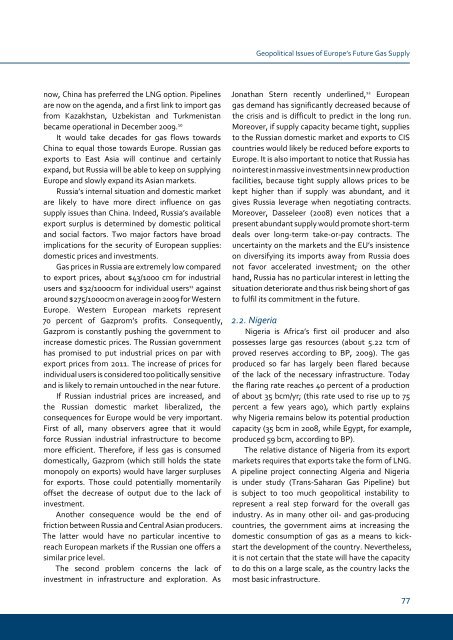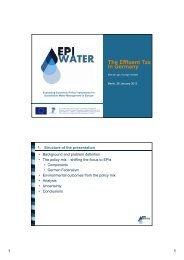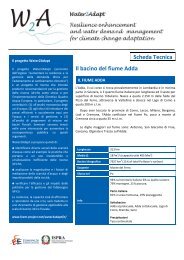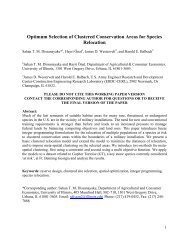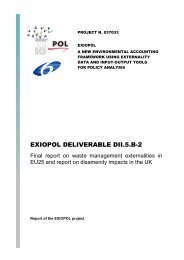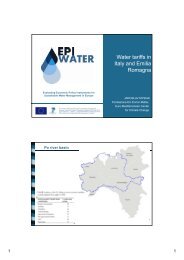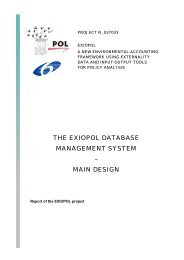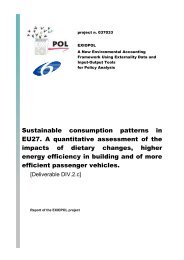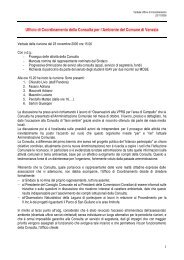Gulf and European Energy Supply Security - Feem-project.net
Gulf and European Energy Supply Security - Feem-project.net
Gulf and European Energy Supply Security - Feem-project.net
You also want an ePaper? Increase the reach of your titles
YUMPU automatically turns print PDFs into web optimized ePapers that Google loves.
now, China has preferred the LNG option. Pipelines<br />
are now on the agenda, <strong>and</strong> a first link to import gas<br />
from Kazakhstan, Uzbekistan <strong>and</strong> Turkmenistan<br />
became operational in December 2009. 10<br />
It would take decades for gas flows towards<br />
China to equal those towards Europe. Russian gas<br />
exports to East Asia will continue <strong>and</strong> certainly<br />
exp<strong>and</strong>, but Russia will be able to keep on supplying<br />
Europe <strong>and</strong> slowly exp<strong>and</strong> its Asian markets.<br />
Russia’s internal situation <strong>and</strong> domestic market<br />
are likely to have more direct influence on gas<br />
supply issues than China. Indeed, Russia’s available<br />
export surplus is determined by domestic political<br />
<strong>and</strong> social factors. Two major factors have broad<br />
implications for the security of <strong>European</strong> supplies:<br />
domestic prices <strong>and</strong> investments.<br />
Gas prices in Russia are extremely low compared<br />
to export prices, about $43/1000 cm for industrial<br />
users <strong>and</strong> $32/1000cm for individual users 11 against<br />
around $275/1000cm on average in 2009 for Western<br />
Europe. Western <strong>European</strong> markets represent<br />
70 percent of Gazprom’s profits. Consequently,<br />
Gazprom is constantly pushing the government to<br />
increase domestic prices. The Russian government<br />
has promised to put industrial prices on par with<br />
export prices from 2011. The increase of prices for<br />
individual users is considered too politically sensitive<br />
<strong>and</strong> is likely to remain untouched in the near future.<br />
If Russian industrial prices are increased, <strong>and</strong><br />
the Russian domestic market liberalized, the<br />
consequences for Europe would be very important.<br />
First of all, many observers agree that it would<br />
force Russian industrial infrastructure to become<br />
more efficient. Therefore, if less gas is consumed<br />
domestically, Gazprom (which still holds the state<br />
monopoly on exports) would have larger surpluses<br />
for exports. Those could potentially momentarily<br />
offset the decrease of output due to the lack of<br />
investment.<br />
Another consequence would be the end of<br />
friction between Russia <strong>and</strong> Central Asian producers.<br />
The latter would have no particular incentive to<br />
reach <strong>European</strong> markets if the Russian one offers a<br />
similar price level.<br />
The second problem concerns the lack of<br />
investment in infrastructure <strong>and</strong> exploration. As<br />
Geopolitical Issues of Europe’s Future Gas <strong>Supply</strong><br />
Jonathan Stern recently underlined, 12 <strong>European</strong><br />
gas dem<strong>and</strong> has significantly decreased because of<br />
the crisis <strong>and</strong> is difficult to predict in the long run.<br />
Moreover, if supply capacity became tight, supplies<br />
to the Russian domestic market <strong>and</strong> exports to CIS<br />
countries would likely be reduced before exports to<br />
Europe. It is also important to notice that Russia has<br />
no interest in massive investments in new production<br />
facilities, because tight supply allows prices to be<br />
kept higher than if supply was abundant, <strong>and</strong> it<br />
gives Russia leverage when negotiating contracts.<br />
Moreover, Dasseleer (2008) even notices that a<br />
present abundant supply would promote short-term<br />
deals over long-term take-or-pay contracts. The<br />
uncertainty on the markets <strong>and</strong> the EU’s insistence<br />
on diversifying its imports away from Russia does<br />
not favor accelerated investment; on the other<br />
h<strong>and</strong>, Russia has no particular interest in letting the<br />
situation deteriorate <strong>and</strong> thus risk being short of gas<br />
to fulfil its commitment in the future.<br />
2.2. Nigeria<br />
Nigeria is Africa’s first oil producer <strong>and</strong> also<br />
possesses large gas resources (about 5.22 tcm of<br />
proved reserves according to BP, 2009). The gas<br />
produced so far has largely been flared because<br />
of the lack of the necessary infrastructure. Today<br />
the flaring rate reaches 40 percent of a production<br />
of about 35 bcm/yr; (this rate used to rise up to 75<br />
percent a few years ago), which partly explains<br />
why Nigeria remains below its potential production<br />
capacity (35 bcm in 2008, while Egypt, for example,<br />
produced 59 bcm, according to BP).<br />
The relative distance of Nigeria from its export<br />
markets requires that exports take the form of LNG.<br />
A pipeline <strong>project</strong> connecting Algeria <strong>and</strong> Nigeria<br />
is under study (Trans-Saharan Gas Pipeline) but<br />
is subject to too much geopolitical instability to<br />
represent a real step forward for the overall gas<br />
industry. As in many other oil- <strong>and</strong> gas-producing<br />
countries, the government aims at increasing the<br />
domestic consumption of gas as a means to kickstart<br />
the development of the country. Nevertheless,<br />
it is not certain that the state will have the capacity<br />
to do this on a large scale, as the country lacks the<br />
most basic infrastructure.


